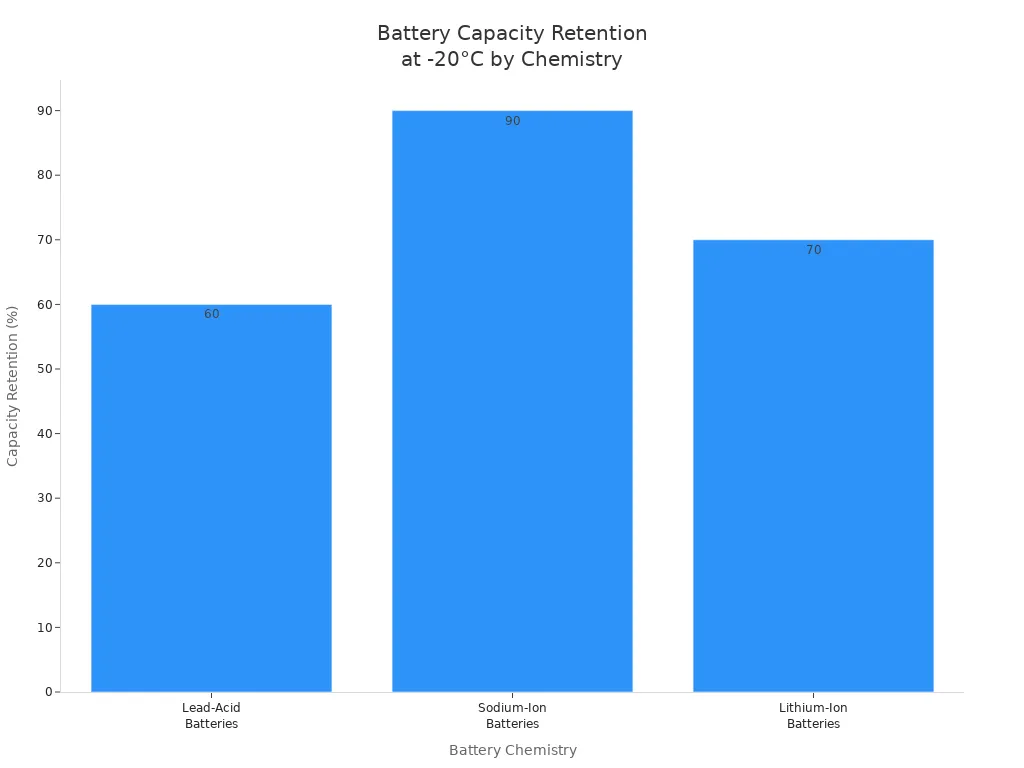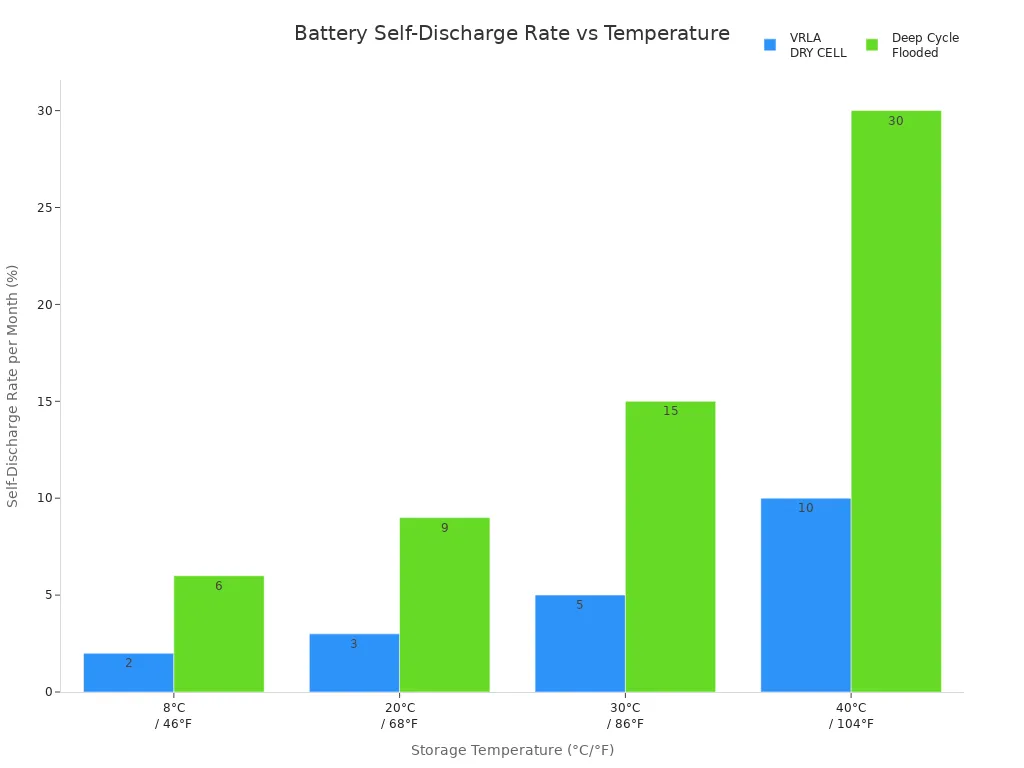
I have seen firsthand how temperature changes can affect a battery’s lifespan. In cooler climates, batteries often last longer. In hot or extreme hot regions, batteries degrade much faster. The chart below shows how battery life expectancy drops as temperatures rise:

Key Point: Temperature directly impacts how long batteries last, with heat causing faster aging and reduced performance.
Key Takeaways
- Cold temperatures reduce battery power and range by slowing chemical reactions and increasing resistance, causing devices to perform poorly.
- High temperatures speed up battery aging, shorten lifespan, and increase risks like swelling, leaks, and fire, so keeping batteries cool is vital.
- Proper storage, temperature-aware charging, and regular monitoring help protect batteries from damage and extend their life in any climate.
Battery Performance in Cold Temperatures

Reduced Capacity and Power
When I use batteries in cold weather, I notice a clear drop in their capacity and power. As temperatures fall below freezing, the battery’s ability to deliver energy drops sharply. For example, lithium-ion batteries can lose up to 40% of their range near 0 °F. Even at milder cold, like the low 30s °F, I see about a 5% reduction in range. This happens because the chemical reactions inside the battery slow down, and the internal resistance increases. The battery cannot deliver as much current, and devices may shut down earlier than expected.
- At 30s °F: about 5% range loss
- At 20s °F: about 10% range loss
- At 10 °F: about 30% range loss
- At 0 °F: up to 40% range loss
Key Point: Cold temperatures cause a significant drop in battery capacity and power, especially as temperatures approach or fall below freezing.
Why Batteries Struggle in the Cold
I have learned that cold weather affects batteries at a chemical and physical level. The electrolyte inside the battery becomes thicker, which slows down the movement of ions. This increased viscosity makes it harder for the battery to deliver energy. The internal resistance rises, causing voltage to drop when I use the battery under load. For instance, a battery that works at 100% capacity at room temperature may only provide about 50% at -18°C. Charging in the cold can also cause lithium plating on the anode, which leads to permanent damage and safety risks.
| Effect of Cold Temperature | Explanation | Impact on Voltage Output |
|---|---|---|
| Increased Internal Resistance | Resistance rises as temperature drops. | Causes voltage to drop, reducing power delivery. |
| Voltage Drop | Higher resistance leads to lower voltage output. | Devices may fail or perform poorly in extreme cold. |
| Reduced Electrochemical Efficiency | Chemical reactions slow down at low temperatures. | Power output and efficiency decrease. |
Key Point: Cold weather increases internal resistance and slows chemical reactions, which leads to voltage drops, reduced capacity, and possible battery damage if charged improperly.
Real-World Data and Examples
I often look at real-world data to understand how cold affects battery performance. For example, a Tesla Model Y owner reported that at -10°C, the car’s battery efficiency dropped to about 54%, compared to over 80% in summer. The car needed more charging stops and could not reach its usual range. Large studies, like Recurrent Auto’s analysis of over 18,000 electric vehicles, confirm that winter conditions consistently reduce battery range by 30-40%. Charging times also increase, and regenerative braking becomes less effective. The Norwegian Automobile Association found that electric vehicles lost up to 32% of their range in cold weather. These findings show that cold weather impacts not just capacity, but also charging speed and overall usability.

Key Point: Real-world data from electric vehicles and consumer electronics show that cold weather can reduce battery range by up to 40%, increase charging times, and limit performance.
Battery Lifespan in Hot Temperatures

Accelerated Aging and Shorter Life
I have seen how high temperatures can dramatically shorten battery lifespan. When batteries operate above 35°C (95°F), their chemical reactions speed up, causing faster aging and irreversible capacity loss. Scientific studies show that batteries exposed to these conditions lose about 20-30% of their expected life compared to those kept in mild climates. For example, in hot regions, battery life expectancy drops to around 40 months, while in colder climates, batteries can last up to 55 months. This difference comes from the increased rate of chemical breakdown inside the battery. Electric vehicle batteries, for instance, last between 12 and 15 years in moderate climates but only 8 to 12 years in places like Phoenix, where extreme heat is common. Even smartphones show faster battery degradation when left in hot environments or charged at high temperatures.
Key Point: High temperatures accelerate battery aging, reducing lifespan by up to 30% and causing faster capacity loss.
Risks of Overheating and Damage
I always pay close attention to the risks that come with overheating. When batteries get too hot, several types of damage can occur. I have seen swollen battery cases, visible fumes, and even batteries emitting a rotten egg smell. Internal short circuits can generate excessive heat, sometimes leading to leakage or fire hazards. Overcharging, especially with faulty charging systems, increases these risks. Age-related wear also causes internal corrosion and heat damage. In severe cases, batteries can experience thermal runaway, which leads to rapid temperature rise, swelling, and even explosions. Reports show that lithium-ion battery fires are increasing, with thousands of incidents each year. On passenger flights, thermal runaway incidents happen twice per week, often causing emergency landings. Most of these incidents result from overheating, physical damage, or improper charging practices.
- Swollen or bloated battery case
- Visible fumes or smoke
- Hot surface with unusual odors
- Internal short circuits and excessive heat
- Leakage, smoking, or fire hazards
- Permanent damage and reduced capacity
Key Point: Overheating can cause swelling, leakage, fire, and permanent battery damage, making safety and proper handling essential.
Comparison Table and Examples
I often compare battery performance across different temperatures to understand the impact of heat. The number of charge cycles a battery can complete drops sharply as temperatures rise. For example, lithium-ion batteries cycled at 25°C can last for about 3,900 cycles before reaching 80% state of health. At 55°C, this number drops to just 250 cycles. This shows how heat drastically reduces battery longevity.
| Temperature (°C) | Number of Cycles to 80% SOH |
|---|---|
| 25 | ~3900 |
| 55 | ~250 |
Different battery chemistries also perform differently in hot climates. Lithium iron phosphate (LFP) batteries offer better resistance to heat and longer cycle life compared to lithium cobalt oxide (LCO) or nickel cobalt aluminum (NCA) batteries. LFP batteries can deliver more effective full charges before degrading, making them preferable for use in hot areas. Industry standards recommend keeping battery temperatures between 20°C and 25°C for optimal performance. Modern electric vehicles use advanced thermal management systems to maintain safe operating temperatures, but heat remains a challenge.
Key Point: High temperatures drastically reduce battery cycle life and increase the risk of damage. Choosing the right battery chemistry and using thermal management systems help maintain safety and longevity.
Battery Care Tips for Any Temperature
Safe Storage Practices
I always prioritize proper storage to maximize battery shelf life. Manufacturers recommend keeping lithium-ion batteries at room temperature, ideally between 15°C and 25°C, with a partial charge of 40–60%. Storing batteries fully charged or at high temperatures accelerates capacity loss and increases safety risks. For nickel-metal hydride batteries, I follow guidelines to store them between -20°C and +35°C and recharge them annually. I avoid leaving batteries in hot cars or direct sunlight, since temperatures can exceed 60°C and cause rapid degradation. I store batteries in cool, dry places with low humidity to prevent corrosion and leakage. The chart below shows how self-discharge rates increase with temperature, highlighting the importance of climate-controlled storage.

Key Point: Store batteries at moderate temperatures and partial charge to prevent accelerated self-discharge and extend shelf life.
Charging Batteries in Extreme Conditions
Charging batteries in extreme cold or heat requires careful attention. I never charge lithium-ion batteries below freezing, as this can cause lithium plating and permanent damage. I use battery management systems that adjust charging current based on temperature, which helps protect battery health. In subzero conditions, I warm batteries slowly before charging and avoid deep discharges. For electric vehicles, I rely on preconditioning features to maintain optimal battery temperature before charging. Smart chargers use adaptive protocols to optimize charging speed and reduce capacity decay, especially in cold environments. I always charge batteries in shaded, ventilated areas and unplug them once fully charged.
Key Point: Use temperature-aware charging strategies and smart chargers to protect batteries from damage in extreme conditions.
Maintenance and Monitoring
Regular maintenance and monitoring help me detect battery issues early. I conduct health checks every six months, focusing on voltage, temperature, and physical condition. I use real-time monitoring systems that provide alerts for temperature or voltage anomalies, allowing immediate response to potential problems. I store batteries in shaded, well-ventilated areas and use insulation or reflective covers to shield them from temperature fluctuations. I avoid fast charging during hot weather and ensure proper ventilation in battery compartments. Seasonal adjustments to maintenance routines help me adapt to environmental changes and optimize battery performance.
Key Point: Routine inspections and real-time monitoring are essential for maintaining battery health and preventing temperature-related failures.
I have seen how temperature shapes battery performance and lifespan. The table below highlights key statistics:
| Statistic | Description |
|---|---|
| Life halving rule | Sealed lead acid battery life halves for every 8°C (15°F) rise. |
| Regional lifespan difference | Batteries last up to 59 months in cooler regions, 47 months in warmer ones. |
- Immersion cooling and advanced thermal management extend battery life and improve safety.
- Proper storage and charging routines help prevent rapid degradation.
Key Point: Protecting batteries from extreme temperatures ensures longer service life and reliable performance.
FAQ
How does temperature affect battery charging?
I notice that charging batteries in extreme cold or heat can cause damage or reduce efficiency. I always charge at moderate temperatures for best results.
Key Point: Charging at moderate temperatures protects battery health and ensures efficient energy transfer.
Can I store batteries in my car during summer or winter?
I avoid leaving batteries in my car during hot summers or freezing winters. Extreme temperatures inside vehicles can shorten battery life or cause safety risks.
Key Point: Store batteries in cool, dry places to prevent damage from temperature extremes.
What signs show that a battery has suffered from temperature damage?
I look for swelling, leaks, or reduced performance. These signs often mean the battery experienced overheating or freezing, which can lead to permanent damage.
Key Point: Physical changes or poor performance signal possible temperature-related battery damage.
Post time: Aug-19-2025




